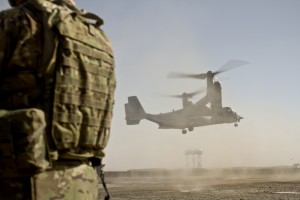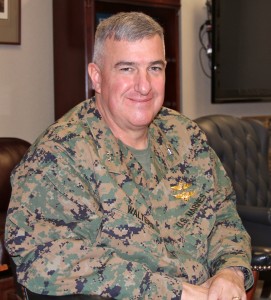April 16, 2012 During the visit to 2nd Marine Corps Air Wing in early March 2012, Second Line of Defense had an opportunity to sit down with General Walters to discuss his recent experience in Afghanistan.
As commander of air operations for 2nd MAW (Forward), Walters had an opportunity to see evolving air operations support to the ground element in Afghanistan. In an earlier interview, Walters underscored the nature of air support in Afghanistan.
General Walters during the SLD Interview Credit Photo: SLD
“About 18 months ago, it was all about Marjah, but now it’s more about Sangin and the fight up north,” said Walters.
“The war has shifted,” added Walters of operations in 2011. “We as aviators have to adjust what we are doing to better support the fight up there.”
In 2010, U.S. Marines and their coalition and Afghan partners carried out a joint offensive, Operation Moshtarak, to rout insurgents from Marjah in Helmand province’s Nad Ali district.
But recent changes center on providing more support in volatile Sangin district. These include establishing forward arming and refueling points to maximize close-air support, creating a detachment of attack helicopters to provide cover for air ambulances, and moving Marine Corps unmanned aerial vehicles north to help in surveillance efforts.
“We have operationally shaped the battle for what the conflict has presented us,” said Walters….
As the battle on the ground shifts, he said, so too must air support.
Partnership for Marines in Afghanistan isn’t limited to their own air and ground forces. Since the beginning of their increased presence in southwestern Afghanistan, U.S. Marines have not fought alone.
The Marines of 2nd Marine Aircraft Wing (Forward) live work and fight side-by-side with coalition partners, particularly members of the British Armed Forces.
“Working with the coalition has been great,” said Walters. “There would be no way we could have done all the things we’ve done without them.”
Aircraft and support troops from the Royal Navy, Royal Air Force and British Army also operate in southwestern Afghanistan with the Joint Aviation Group.
“We are fully integrated into the MAW,” explained Royal Navy Lt. Cmdr. Gary Soar, the chief of staff of the British Joint Aviation Group. “The cooperation, interaction, and the way we share knowledge have definitely allowed us to learn from one another and adopt new methods,”
“Working with U.S. Marines has been a privilege,” Soar added. “They do a fantastic job and are a very flexible and proactive outfit. Every one of their squadrons has been an absolute pleasure to work with.”
The British and American forces also work daily with Afghan troops. While the Afghan National Army builds its aerial capabilities, they remain largely reliant on U.S. and coalition aircraft for operational, logistical and medical support.
“The Afghan forces are treated just like any of the other coalition forces,” said Soar. “We help them out where we can. If someone needs helicopter support we’ll supply it.”
Soar expressed that he looks forward to seeing continued integration between British and American air assets. He said the highlight of his tour so far has been the combined effort between U.S., British and Afghan forces to eliminate insurgent threats in the villages of Geresh district, Helmand province.
General Walters has just arrived from Afghanistan to prepare to become the CG of 2nd MAW. And during the meeting with the current CG, General “Dog” Davis, there was a chance to discuss his recent experience in Afghanistan.
SLD: General Davis has mentioned the use of the Ospreys and how they are changing operations. How you use the Ospreys in Afghanistan?
General Walters: They had their normal fair share of general support, resupplies, etc. But we started accelerating their use as my time there went on, and used them for both the conventional and Special Forces operations.
The beauty of the speed of the Osprey is that you can get the Special Operations forces where they need to be and to augment what the conventional forces were doing and thereby take pressure off of the conventional forces. And with the SAME assets, you could make multiple trips or make multiple hits, which allowed us to shape what the Taliban was trying to do.
The Taliban has a very rudimentary but effective early warning system for counter-air. They spaced guys around their area of interest, their headquarters, etc. Then they would call in on cell or satellite phones to chat or track. It was very easy for them to track. They had names for our aircraft, like the CH-53s, which they called “Fat Cows.”
But they did not talk much about the Osprey because they were so quick and lethal.
And because of its speed and range, you did not have to come on the axis that would expect. You could go around, or behind them and then zip in. We also started expanding our night operations with the Osprey. We rigged up a V-22 for battlefield illumination.

A lot of these mission sets were never designed into the V-22 but you put it into the field and configure it to do the various missions required. And we have new software for the Ospreys in Afghanistan where you can pick your approach, angle, approach speed and let the aircraft do it all. That is a huge safety gain.
SLD: And this is occurring in a very difficult environment to operate for sure.
General Walters: In a very difficult environment. If you had to go, we would prefer to send in a V-22. You did not have to worry about that young captain or lieutenant flying it in and losing the bubble a little bit. You could just let the airplane do it for you. And the fact that you could get the force where it needs to be very quickly is becoming a staple of our operational approach.
SLD: Both to get in and to get out quickly.
General Walters: Or to get out quickly. And the speed and the agility of the aircraft also enhance survivability.
During my year there, I only had two V-22s that got a hole in them for an enemy bullet. Every other helicopter, including the British, was hit frequently.
Because of their speed, the Ospreys could get in and out and move from the threat area quickly.
SLD: As we face transition in Afghanistan, one option clearly is to rely more on the Special Forces type of support to the Afghans against the insurgency. Your experience in many ways presages such an effort. How would your experience shape understanding from a professional military point of view of how to best support the Afghans with a Special Forces type of support?
General Walters: Our role will be to support the Afghan security forces. You’re going to have to support those guys, and they’re going to be much more distributed. You’re not going to have the battalions out there that you support people on the FABs. It’s going to have to be from a central location. And the QRF (Quick Reaction Force) is going to have to be good, and it’s going to have to be there quickly.
In the end, we have to be able to prove to the Afghan security forces that if something happens, this platoon is good enough until we get someone in there.
If you ever need more than a platoon’s worth of trigger pullers in a district center, the V22s is how you’re going to get there quickly and decisively enough to matter.
The Afghan National Army and Afghan Security Forces understand from their perspective, how important air is. We have made them big consumers.
They know that the air is there for them; they’ll go out and operate. I’ve had more than one brigade commander tell me that if it wasn’t for the medevac, it wasn’t for the resupply, and if it wasn’t for the aviation fires, he didn’t think he could get the battalions out operating like they do. Because they’ve learned that if they get hurt, we’ll fix them. They know if they run out of bullets, we’ll get them bullets. And if they’re hungry or thirsty, we’ll get them food and water.


